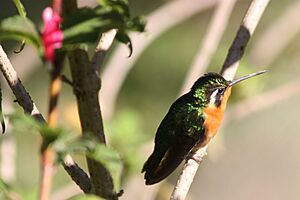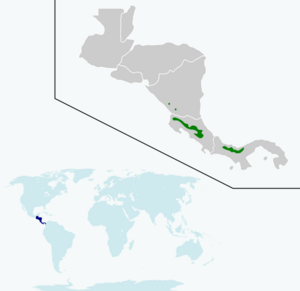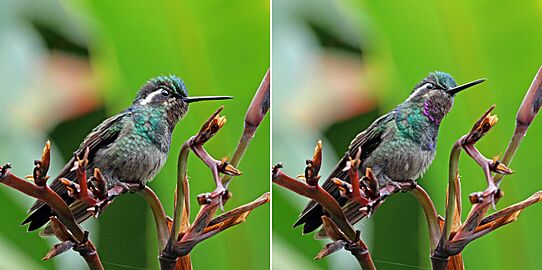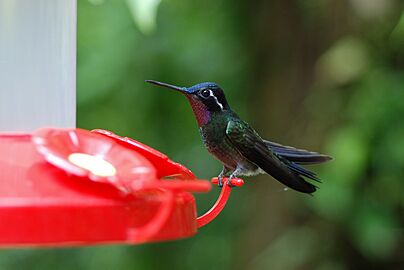Purple-throated mountaingem facts for kids
Quick facts for kids Purple-throated mountaingem |
|
|---|---|
 |
|
| Male in Costa Rica | |
 |
|
| Female in Costa Rica | |
| Conservation status | |
| Scientific classification | |
| Genus: |
Lampornis
|
| Species: |
calolaemus
|
 |
|
| Range of L. calolaemus | |
| Synonyms | |
|
Lampornis calolaema (lapsus) |
|
The purple-throated mountaingem (Lampornis calolaemus) is a beautiful hummingbird found in Central America. You can spot it in countries like Costa Rica, Nicaragua, and Panama. These tiny birds are known for their bright colors and quick movements.
Contents
Understanding the Purple-throated Mountaingem's Family Tree
Scientists group animals based on how they are related. The purple-throated mountaingem's family tree has been a bit tricky to figure out. For a while, some experts thought it was the same species as the white-throated mountaingem and gray-tailed mountaingem.
However, today, the purple-throated mountaingem is considered its own unique species. It has three main types, called subspecies. These are L. c. calolaemus, L. c. pectoralis, and L. c. homogenes. All three types are very closely related. They started evolving about 3.5 million years ago.
What Does a Purple-throated Mountaingem Look Like?
This hummingbird is quite small, measuring about 10 to 11.5 cm (3.9 to 4.5 in) long. It weighs only 4.5 to 6 g (0.16 to 0.21 oz), which is less than a few paper clips! Both male and female birds have a straight, black bill that is medium in length. They also have a white stripe behind their eye and a fairly long tail.
Male Purple-throated Mountaingem's Appearance
Adult males of the main type, L. c. calolaemus, are very colorful.
- Their forehead and crown (top of the head) are a sparkling emerald green or bluish green.
- The rest of their upper body is a metallic bronze-green. This color changes to bluish or grass green near their tail feathers.
- Their face is a dark bronze-green.
- The throat area, called a gorget, is a shiny violet or purple.
- Their chest is bright metallic green. The sides and belly are a duller bronze-green or gray.
- The feathers under their tail are deep bronzy gray with lighter edges.
- Their tail is a dull blue-black color.
Female Purple-throated Mountaingem's Appearance
Adult females of the main type look different from the males.
- Their upper body is a bright metallic green. It might look a bit bluish on the tail feathers and bronzish elsewhere.
- Their face is mostly blackish.
- Their throat, chest, and belly are a tawny yellow color.
- The feathers under their tail are dull white to tawny buff.
- The middle tail feathers are dull metallic green or bronze-green.
- The outer tail feathers are mostly black with light gray tips on the lower half.
Young Male Purple-throated Mountaingem's Appearance
Young males of the main type look a lot like adult females. However, they have a darker chin and throat. Their undertail feathers are brownish gray with dull white edges.
Differences in Subspecies
- Males of the L. c. pectoralis subspecies have a deeper purple throat than the main type. Their green neck and tail feathers are darker. Their belly and undertail feathers are also darker.
- Males of the L. c. homogenes subspecies are similar to the main type but have a darker gray chest and belly.
- Females of L. c. homogenes have more bluish-green upper parts. Their central tail feathers are a darker bronze-green. Their underparts are darker and more reddish.
Where Do Purple-throated Mountaingems Live?
The different types of purple-throated mountaingems live in specific areas:
- The L. c. pectoralis subspecies is found in southwestern Nicaragua and northwestern Costa Rica.
- The main type, L. c. calolaemus, lives in central and northern Costa Rica.
- The L. c. homogenes subspecies is found in western Panama. It likely also lives in southern Costa Rica.
These hummingbirds prefer to live in humid mountain forests. They like areas with steep slopes and uneven ground. In central Costa Rica, they live at elevations from 1,200 to 2,500 m (3,900 to 8,200 ft). In northern Costa Rica, they can be found as low as 800 m (2,600 ft).
Purple-throated Mountaingem Behavior
Seasonal Movements
In some places, after the breeding season, purple-throated mountaingems move to lower elevations. They might go as low as 300 m (980 ft).
What and How They Eat
Purple-throated mountaingems mainly eat nectar from flowers.
- Male hummingbirds often protect patches of flowers. They chase away other hummingbirds, including other males of their own kind. They even chase away females after they have courted them.
- Females are less protective of flower patches. They often feed by flying a regular path between different flowers, like following a "trap-line."
They get nectar from many different kinds of flowers. This hummingbird is very important for pollinating certain plants, like Psychotria elata and Palicourea lasiorrachis.
Female hummingbirds have slightly longer bills than males. This helps them reach nectar in flowers with longer, thinner tubes. While both sexes like flowers with tubes 14 to 21 mm (0.55 to 0.83 in) long and 3.5 to 8 mm (0.14 to 0.31 in) wide, females often use plants with much longer flower tubes.
Like most hummingbirds, they also eat insects.
- Males catch insects by "hawking." This means they sit on a branch and fly out to snatch insects from the air.
- Females often "hover-glean." They hover near leaves and beat their wings against them. This seems to scare insects out, which they then catch.
Reproduction and Life Cycle
Purple-throated mountaingems breed between October and April. This is during the rainy season. The female hummingbird does all the work for nesting and raising the young.
- She builds a strong, open cup-shaped nest. It's made of plant fibers with moss and lichen on the outside.
- The nest is usually placed about 2 m (7 ft) above the ground. She puts it in the lower parts of the forest, often on bamboo or a small tree.
- The female lays two white eggs. She sits on them to keep them warm (incubates) for 17 to 18 days.
- The young birds leave the nest (fledge) about 22 to 23 days after they hatch.
Sounds and Calls
The song of the purple-throated mountaingem is described as "high, thin, and dry." It's a mix of sputtering and warbling sounds. They also make a common call that sounds like "trrrt" or a sharp, buzzing "zeet" or "zeep." When they interact with other hummingbirds, they make "higher-pitched, scratchy, chattering notes."
How Are Purple-throated Mountaingems Doing?
The IUCN (International Union for Conservation of Nature) has looked at the purple-throated mountaingem. They have listed it as a species of "Least Concern." This means it is not currently in danger of disappearing.
Scientists estimate there are between 50,000 and 500,000 adult birds. However, this number is thought to be slowly going down. No major threats have been found for them. Even though some of their forest homes have been changed by people, a lot of their habitat is still untouched. Studies show that these hummingbirds are quite strong and can adapt well, even when their homes change a bit.
Gallery
-
This picture shows how the male's throat color changes with light. Taken in Mount Totumas cloud forest, Panama.




